Electroluminescence Imaging Based on FFT Analysis for Outdoor Photovoltaic Module Inspection: A Self-Powered Signal Modulation Approach
Abstract
1. Introduction
2. Materials and Methods
2.1. Imaging Acquistion Set-Up
2.2. FFT Imaging Processing
3. Results
3.1. Current and Signal Modulation
3.2. Conventional Power Supply Aproach
3.3. Self-Powered Electronic Board Aproach
4. Discussion and Conclusions
Author Contributions
Funding
Institutional Review Board Statement
Informed Consent Statement
Data Availability Statement
Acknowledgments
Conflicts of Interest
Abbreviations
| CdTe | Cadmium Telluride |
| EL | Electroluminescence |
| FFT | Fast Fourier Transformation |
| InGaAs | Indium Gallium Arsenide |
| I-V | Current-Voltage |
| LC | L-inductor C-capacitor |
| MOSFET | Metal-Oxide-Semiconductor Field-Effect Transistor |
| MPP | Maximum Power Point |
| MPPT | Maximum Power Point Tracking |
| PERC | Passivated Emitter and Rear Contact |
| PL | Photoluminescence |
| PV | Photovoltaic |
| PWM | Pulse Width Modulation |
| TOPCon | Tunnel Oxide Passivated Contact |
| UAVs | Unnamed Aerial Vehicles |
| UV | Ultraviolet |
References
- IEA. Electricity 2024 Analysis and Forecast to 2030; IEA: Paris, France, 2023. [Google Scholar]
- Waqar Akram, M.; Li, G.; Jin, Y.; Chen, X. Failures of Photovoltaic Modules and Their Detection: A Review. Appl. Energy 2022, 313, 118822. [Google Scholar] [CrossRef]
- Köntges, M.; Jahn, U.; Berger, K.A.; Friesen, T. Review of Failures of Photovoltaic Modules; SUPSI: Verscio, Switzerland, 2014. [Google Scholar]
- Høiaas, I.; Grujic, K.; Imenes, A.G.; Burud, I.; Olsen, E.; Belbachir, N. Inspection and Condition Monitoring of Large-Scale Photovoltaic Power Plants: A Review of Imaging Technologies. Renew. Sustain. Energy Rev. 2022, 161, 112353. [Google Scholar] [CrossRef]
- Peinado Gonzalo, A.; Pliego Marugán, A.; García Márquez, F.P. Survey of Maintenance Management for Photovoltaic Power Systems. Renew. Sustain. Energy Rev. 2020, 134, 110347. [Google Scholar] [CrossRef]
- Hong, Y.-Y.; Pula, R.A. Methods of Photovoltaic Fault Detection and Classification: A Review. Energy Rep. 2022, 8, 5898–5929. [Google Scholar] [CrossRef]
- Niccolai, A.; Gandelli, A.; Grimaccia, F.; Zich, R.; Leva, S. Overview on Photovoltaic Inspections Procedure by Means of Unmanned Aerial Vehicles. In Proceedings of the 2019 IEEE Milan PowerTech, Milan, Italy, 23–27 June 2019; pp. 1–6. [Google Scholar]
- Kandeal, A.W.; Elkadeem, M.R.; Kumar Thakur, A.; Abdelaziz, G.B.; Sathyamurthy, R.; Kabeel, A.E.; Yang, N.; Sharshir, S.W. Infrared Thermography-Based Condition Monitoring of Solar Photovoltaic Systems: A Mini Review of Recent Advances. Sol. Energy 2021, 223, 33–43. [Google Scholar] [CrossRef]
- Schirripa Spagnolo, G.; Del Vecchio, P.; Makary, G.; Papalillo, D.; Martocchia, A. A Review of IR Thermography Applied to PV Systems. In Proceedings of the 2012 11th International Conference on Environment and Electrical Engineering, Venice, Italy, 18–25 May 2012; pp. 879–884. [Google Scholar]
- Ulrike Jahn, M.H.; Köntges, M.; Parlevliet, D.; Pagg, M.; Tsanakas, I.; Stein, J.S.; Berger, K.A.; Ranta, S.; French, R.H.; Richter, M.; et al. Review on Infrared and Electroluminescence Imaging for PV Field Applications; IEA: Paris, France, 2018. [Google Scholar]
- Dhimish, M.; Badran, G. Investigating Defects and Annual Degradation in UK Solar PV Installations through Thermographic and Electroluminescent Surveys. NPJ Mater. Degrad. 2023, 7, 14. [Google Scholar] [CrossRef]
- Redondo-Plaza, A.; Zorita-Lamadrid, Á.L.; Hernández-Callejo, L.; Alonso-Gómez, V. Inspection Techniques in Photovoltaic Power Plants: A Review of Electroluminescence and Photoluminescence Imaging. Renew. Energ. 2024, 2, 27533735241282603. [Google Scholar] [CrossRef]
- Kunz, O.; Schlipf, J.; Fladung, A.; Khoo, Y.S.; Bedrich, K.; Trupke, T.; Hameiri, Z. Outdoor Luminescence Imaging of Field-Deployed PV Modules. Prog. Energy 2022, 4, 042014. [Google Scholar] [CrossRef]
- Fuyuki, T.; Kondo, H.; Yamazaki, T.; Takahashi, Y.; Uraoka, Y. Photographic Surveying of Minority Carrier Diffusion Length in Polycrystalline Silicon Solar Cells by Electroluminescence. Appl. Phys. Lett. 2005, 86, 262108. [Google Scholar] [CrossRef]
- Weber, T.; Albert, A.; Ferretti, N.; Roericht, M.; Krauter, S.; Grunow, P. Electroluminescence Investigation of Thin Film Modules. In Proceedings of the EUPVSEC 2011, Hamburg, Germany, 5–9 September 2011. [Google Scholar]
- Colvin, D.J.; Schneller, E.J.; Horner, G.S.; Gabor, A.M.; Davis, K.O. Evaluating Impact on Electroluminescence Image Quality and Quantitative Analysis Using Different Camera Technologies. In Proceedings of the 2021 IEEE 48th Photovoltaic Specialists Conference (PVSC), Fort Lauderdale, FL, USA, 20–25 June 2021; pp. 1057–1061. [Google Scholar]
- dos Reis Benatto, G.A.; Kari, T.; Del Prado Santamaría, R.; Mahmood, A.; Stoicescu, L.; Spataru, S.V. Evaluation of Daylight Filters for Electroluminescence Imaging Inspections of Crystalline Silicon Photovoltaic Modules. Solar RRL 2025, 9, 2400654. [Google Scholar] [CrossRef]
- Stoicescu, L.; Reuter, M.; Werner, J.H. DaySy: Luminiscence Imaging of PV Modules in Daylight. In Proceedings of the 29th European Photovoltaic Solar Energy Conference Exhibition, Amsterdam, The Netherlands, 22–26 September 2014. [Google Scholar]
- Guada, M.; Moretón, Á.; Rodríguez-Conde, S.; Sánchez, L.A.; Martínez, M.; González, M.Á.; Jiménez, J.; Pérez, L.; Parra, V.; Martínez, O. Daylight Luminescence System for Silicon Solar Panels Based on a Bias Switching Method. Energy Sci. Eng. 2020, 8, 3839–3853. [Google Scholar] [CrossRef]
- Kropp, T.; Berner, M.; Stoicescu, L.; Werner, J.H. Self-Sourced Daylight Electroluminescence From Photovoltaic Modules. IEEE J. Photovolt. 2017, 7, 1184–1189. [Google Scholar] [CrossRef]
- Bhoopathy, R.; Kunz, O.; Juhl, M.; Trupke, T.; Hameiri, Z. Outdoor Photoluminescence Imaging of Photovoltaic Modules with Sunlight Excitation. Prog. Photovolt. Res. Appl. 2018, 26, 69–73. [Google Scholar] [CrossRef]
- Bhoopathy, R.; Kunz, O.; Juhl, M.; Trupke, T.; Hameiri, Z. Outdoor Photoluminescence Imaging of Solar Panels by Contactless Switching: Technical Considerations and Applications. Prog. Photovolt. Res. Appl. 2020, 28, 217–228. [Google Scholar] [CrossRef]
- Kunz, O.; Rey, G.; Juhl, M.K.; Trupke, T. High Throughput Outdoor Photoluminescence Imaging via PV String Modulation. In Proceedings of the 2021 IEEE 48th Photovoltaic Specialists Conference (PVSC), Fort Lauderdale, FL, USA, 20–25 June 2021; pp. 346–350. [Google Scholar]
- Ballestín-Fuertes, J.; Muñoz-Cruzado-Alba, J.; Sanz-Osorio, J.F.; Hernández-Callejo, L.; Alonso-Gómez, V.; Morales-Aragones, J.I.; Gallardo-Saavedra, S.; Martínez-Sacristan, O.; Moretón-Fernández, Á. Novel Utility-Scale Photovoltaic Plant Electroluminescence Maintenance Technique by Means of Bidirectional Power Inverter Controller. Appl. Sci. 2020, 10, 3084. [Google Scholar] [CrossRef]
- Kunz, O.; Rey, G.; Bhoopathy, R.; Hameiri, Z.; Trupke, T. Outdoor PL Imaging of Crystalline Silicon Modules at Constant Operating Point. In Proceedings of the 2020 47th IEEE Photovoltaic Specialists Conference (PVSC), Calgary, AB, Canada, 15 June–21 August 2020; pp. 2140–2143. [Google Scholar]
- Doll, B.; Wittmann, E.; Lüer, L.; Hepp, J.; Buerhop-Lutz, C.; Hauch, J.A.; Brabec, C.J.; Peters, I.M. Aerial Photoluminescence Imaging of Photovoltaic Modules. Phys. Status Solidi (RRL)–Rapid Res. Lett. 2023, 17, 2300059. [Google Scholar] [CrossRef]
- Doll, B.; Hepp, J.; Hoffmann, M.; Schuler, R.; Buerhop-Lutz, C.; Peters, I.M.; Hauch, J.A.; Maier, A.; Brabec, C.J. Photoluminescence for Defect Detection on Full-Sized Photovoltaic Modules. IEEE J. Photovolt. 2021, 11, 1419–1429. [Google Scholar] [CrossRef]
- Weber, J.W.; Kunz, O.; Knaack, C.; Chung, D.; Barson, A.; Slade, A.; Ouyang, Z.; Gottlieb, H.; Trupke, T. Daylight Photoluminescence Imaging of Photovoltaic Systems Using Inverter-based Switching. Prog. Photovolt. Res. Appl. 2024, 32, 643–651. [Google Scholar] [CrossRef]
- Vuković, M.; Eriksdatter Høiaas, I.; Jakovljević, M.; Svarstad Flø, A.; Olsen, E.; Burud, I. Photoluminescence Imaging of Silicon Modules in a String. Prog. Photovolt. Res. Appl. 2022, 30, 436–446. [Google Scholar] [CrossRef]
- Vuković, M.; Jakovljević, M.; Flø, A.S.; Olsen, E.; Burud, I. Noninvasive Photoluminescence Imaging of Silicon PV Modules in Daylight. Appl. Phys. Lett. 2022, 120, 244102. [Google Scholar] [CrossRef]
- Vuković, M.; Hillestad, M.; Jakovljević, M.; Flø, A.S.; Olsen, E.; Burud, I. Photoluminescence Imaging of Field-Installed Photovoltaic Modules in Diffuse Irradiance. J. Appl. Phys. 2023, 134, 074903. [Google Scholar] [CrossRef]
- Vuković, M.; Wiig, M.S.; dos Reis Benatto, G.A.; Olsen, E.; Burud, I. A Review of Imaging Methods for Detection of Photoluminescence in Field-Installed Photovoltaic Modules. Prog. Energy 2024, 6, 032001. [Google Scholar] [CrossRef]
- Rey, G.; Kunz, O.; Green, M.; Trupke, T. Luminescence Imaging of Solar Modules in Full Sunlight Using Ultranarrow Bandpass Filters. Prog. Photovolt. Res. Appl. 2022, 30, 1115–1121. [Google Scholar] [CrossRef]
- Redondo-Plaza, A.; Morales-Aragonés, J.I.; Gallardo-Saavedra, S.; Mateo-Romero, H.F.; Araujo-Rendón, S.; Zorita-Lamadrid, Á.L.; Alonso-Gómez, V.; Hernández-Callejo, L. Passive Electroluminescence and Photoluminescence Imaging Acquisition of Photovoltaic Modules. Sensors 2024, 24, 1539. [Google Scholar] [CrossRef]
- dos Reis Benatto, G.A.; Kari Hass, T.; Del Prado Santamaria, R.; Viorel Spataru, S. Daylight Electroluminescence Imaging Methodology Comparison. In Proceedings of the 40th European Photovoltaic Solar Energy Conference and Exhibition, Lisbon, Portugal, 18–22 September 2023. [Google Scholar]
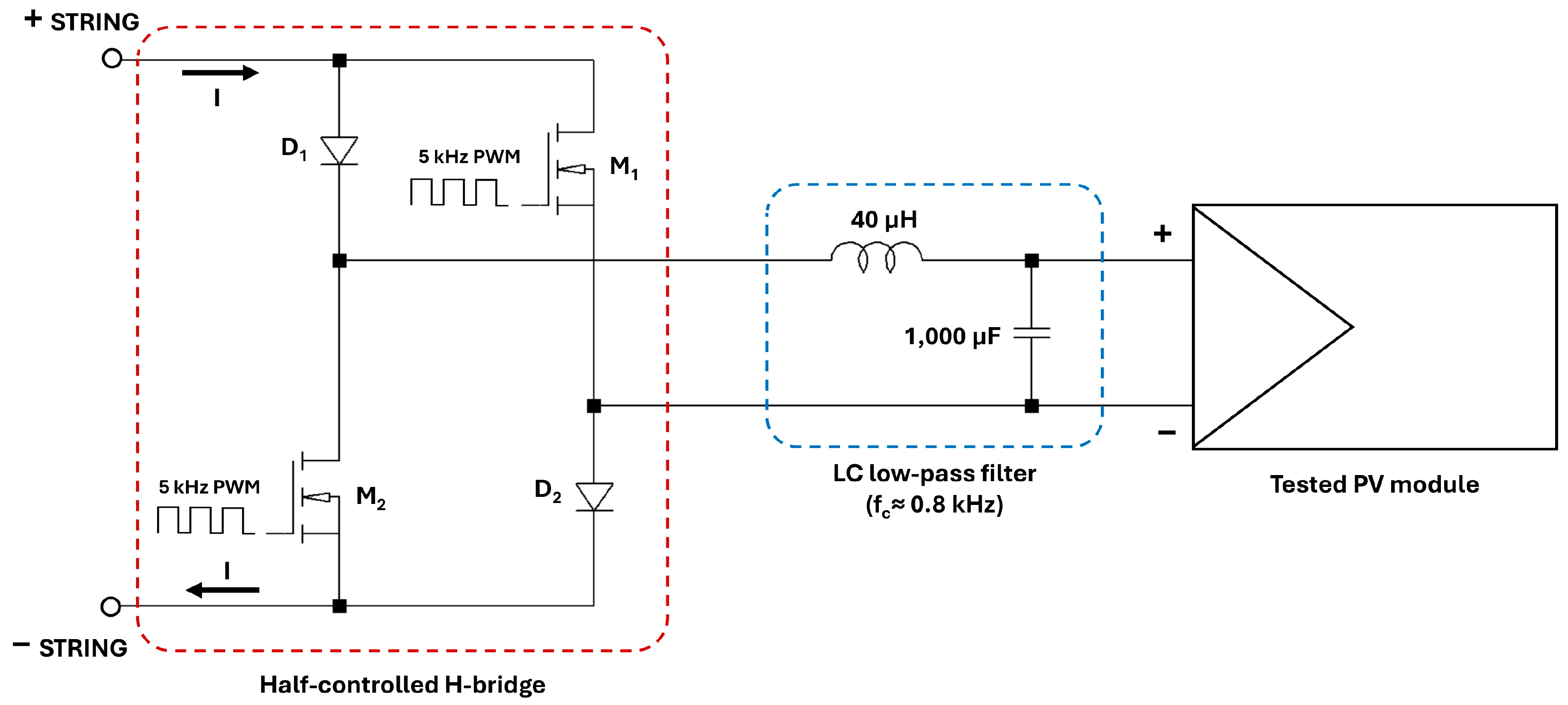
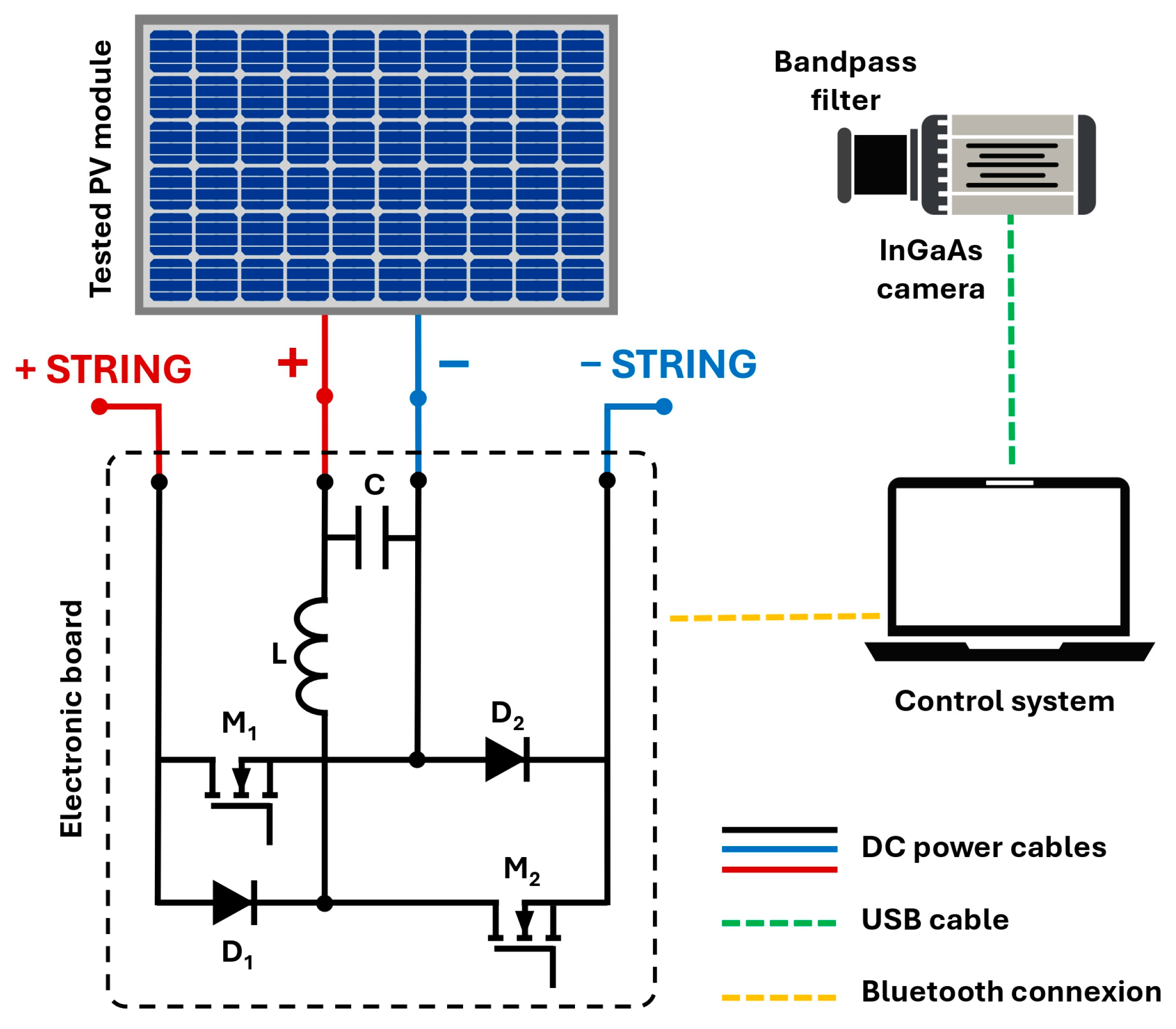
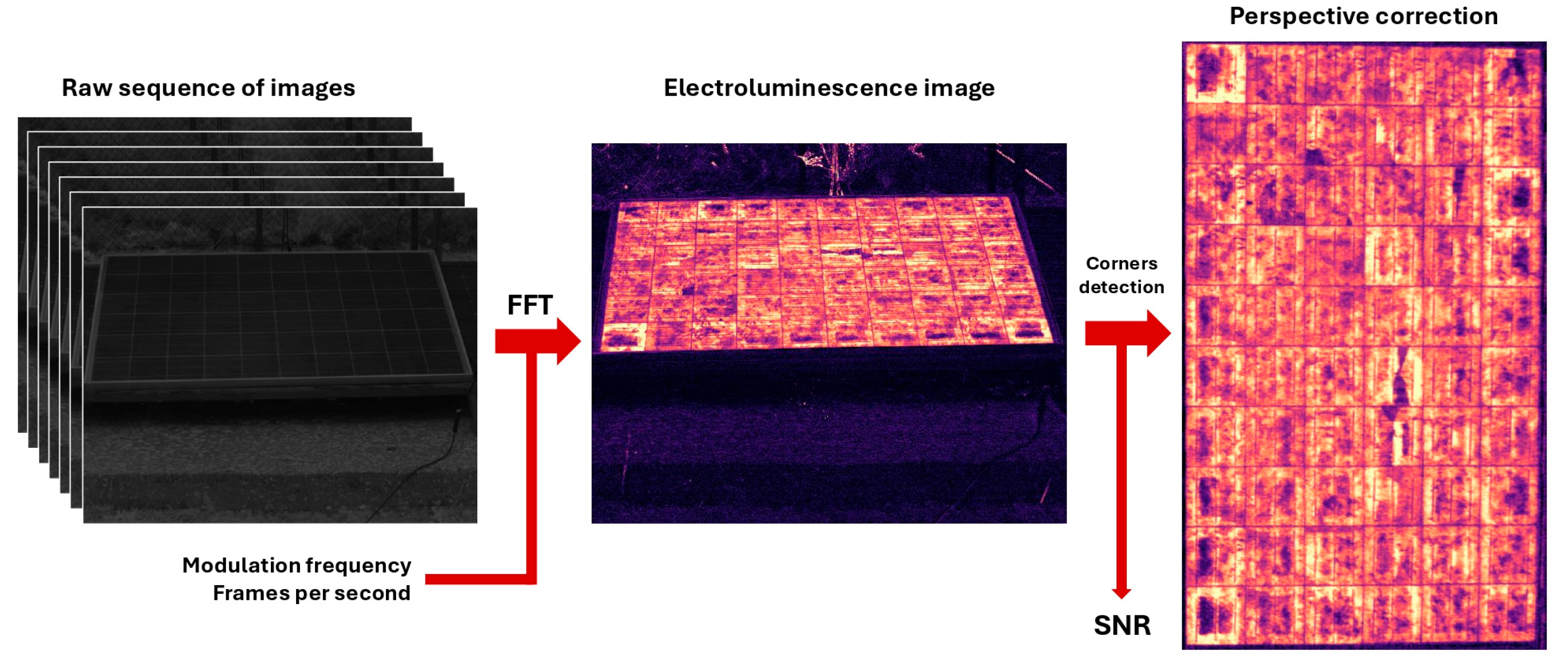
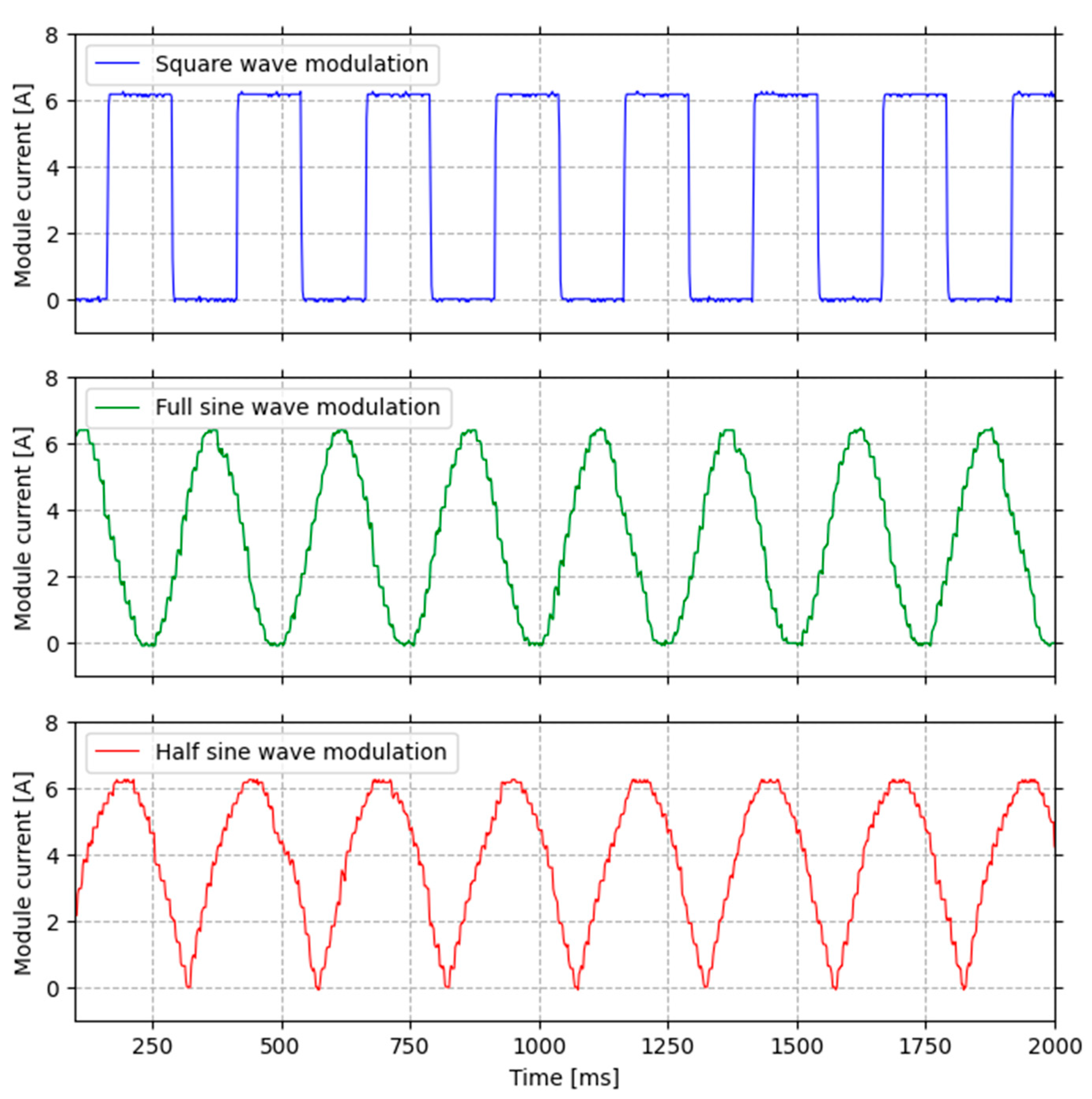
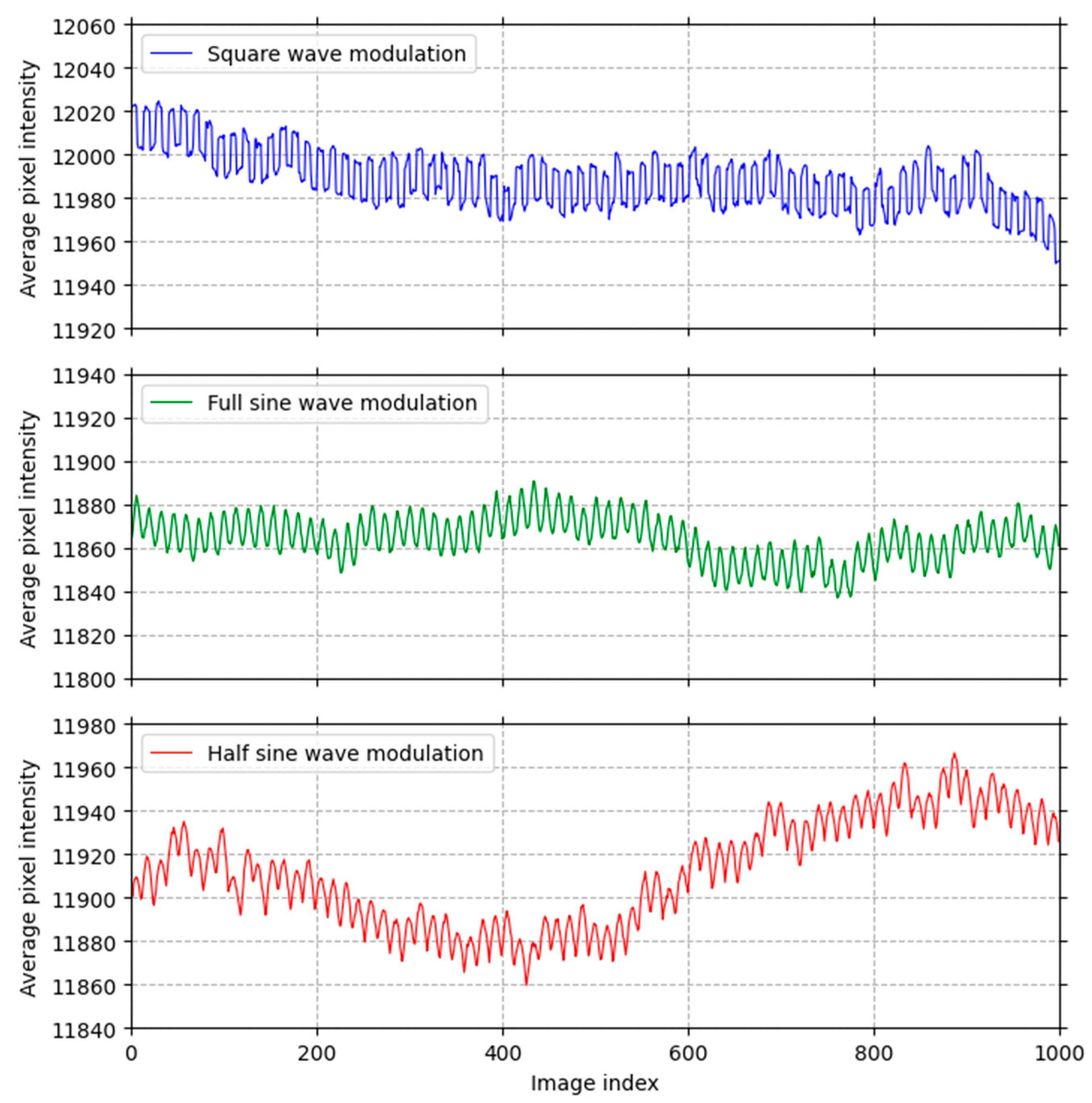
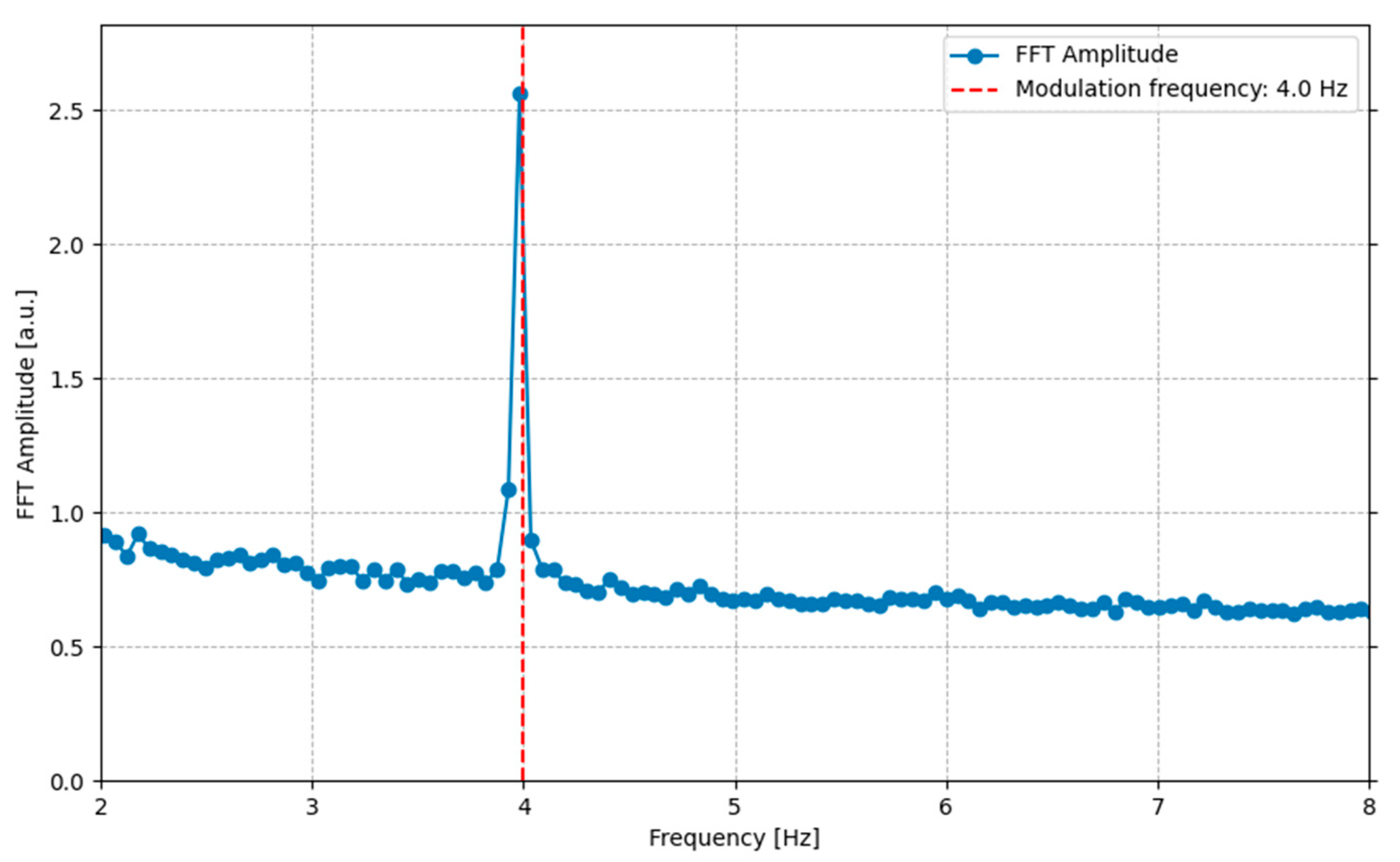
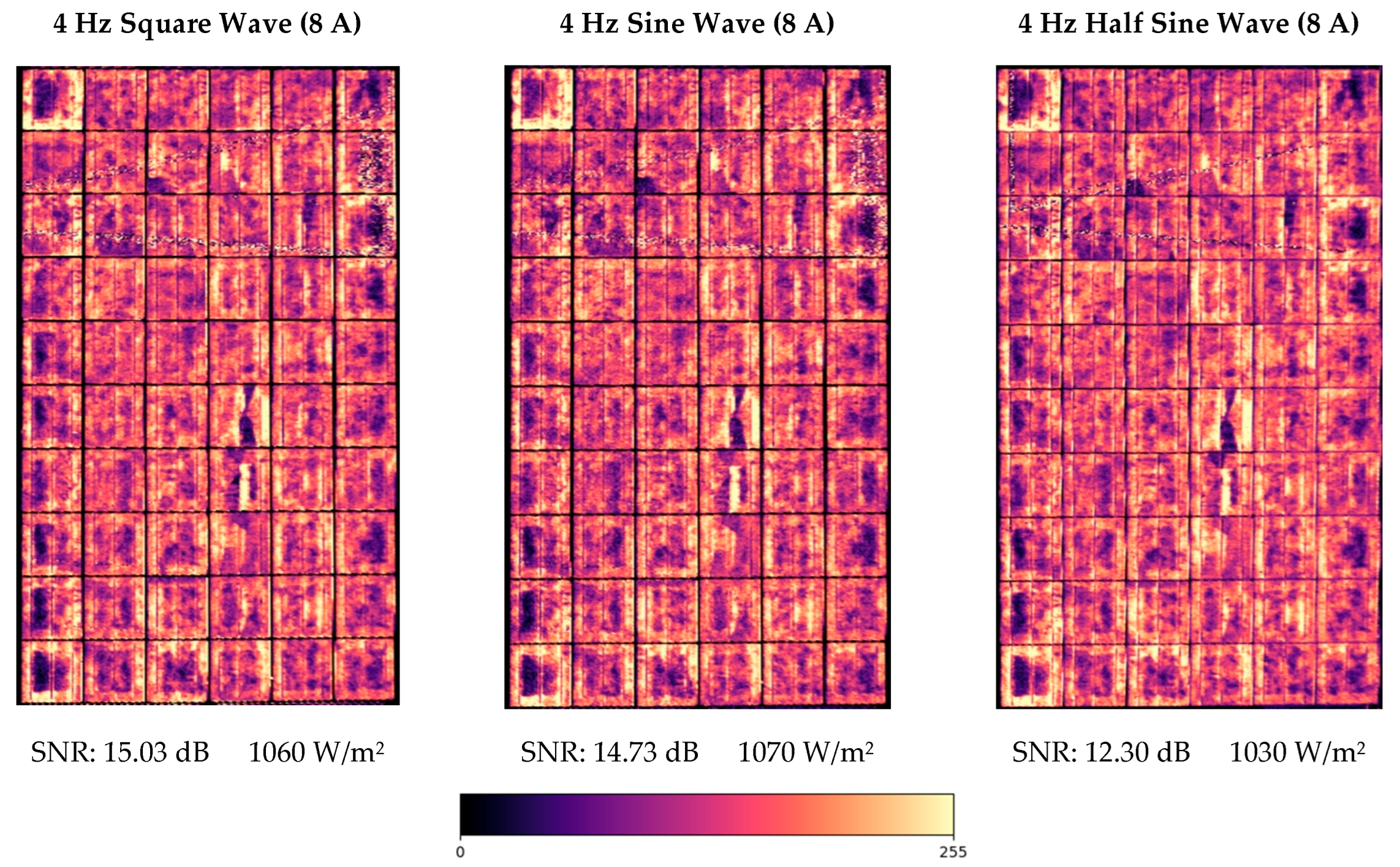
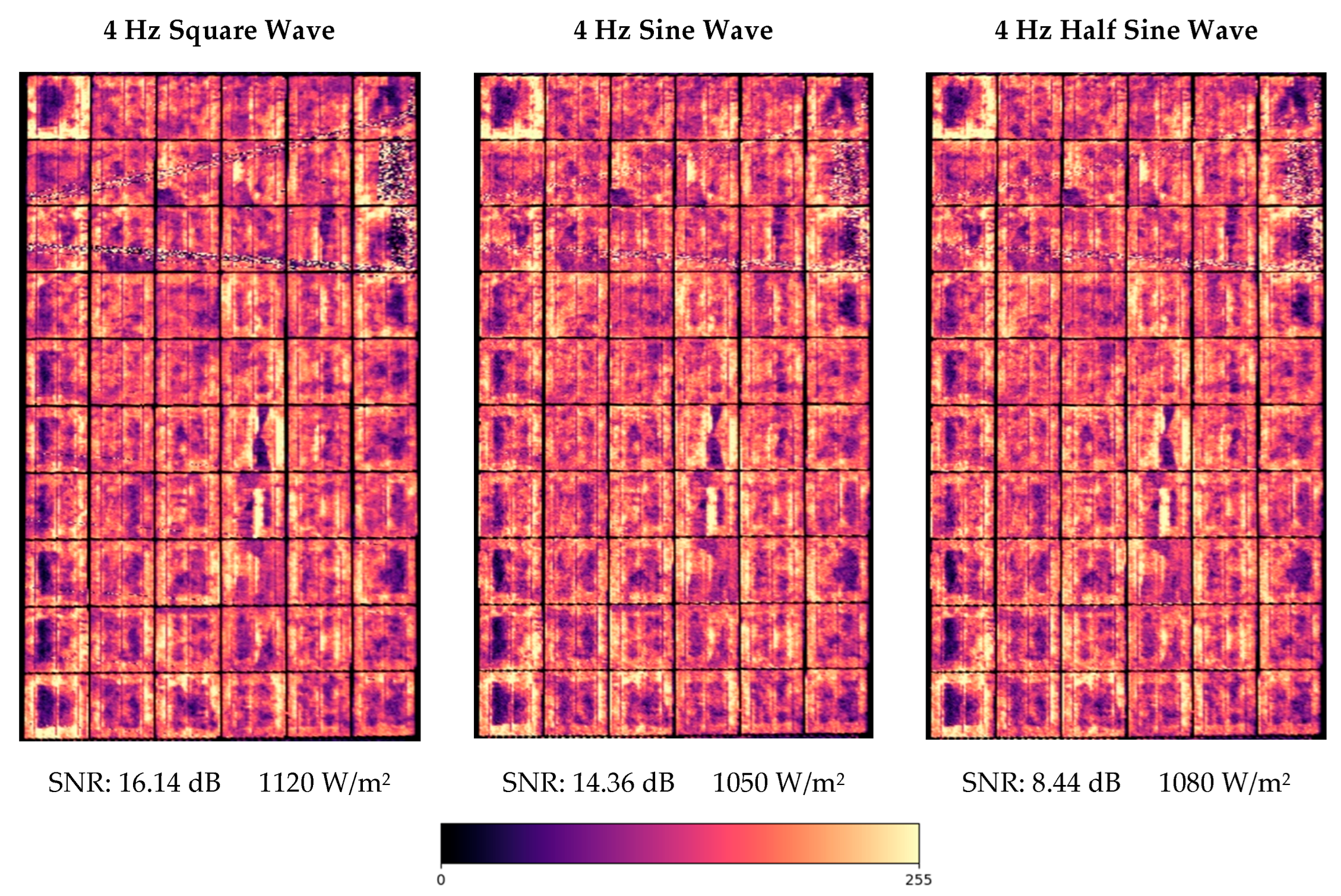
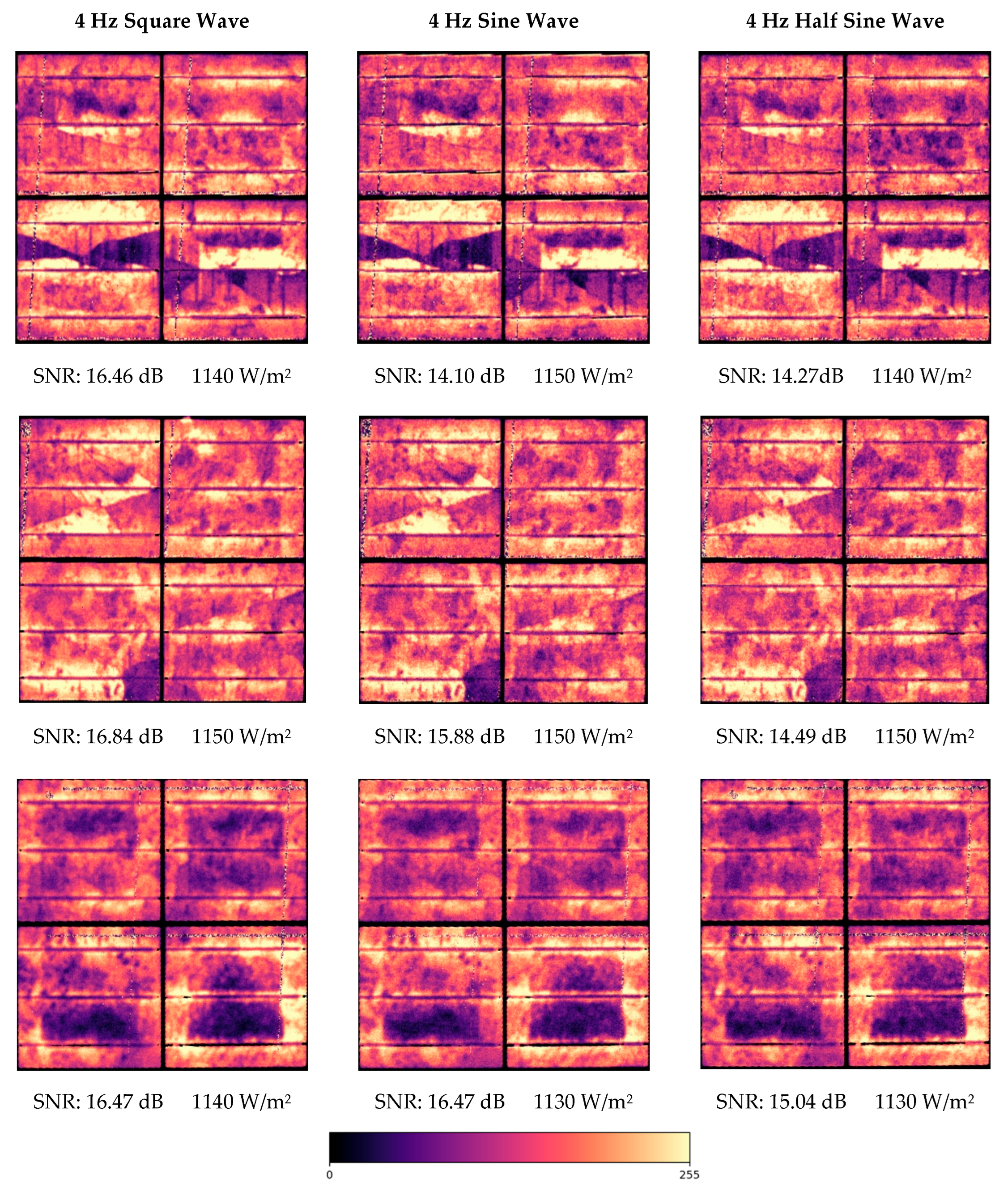
| Ref./Year | EL/PL | Day/Night | Excitation Source | Equipment for Modulation | PV Module Disconnection | Camera Sensor | Filter |
|---|---|---|---|---|---|---|---|
| [18,19] 2014 | EL/PL | Day/night | Power supply (EL) or electronic board (PL) | Power supply (EL) or electronic board (PL) | Required | InGaAs sensor Optical bandpass filter | Optical bandpass filter |
| [20] 2017 | EL | Day | PV module current | Electronic board | Required | InGaAs sensor Optical bandpass filter | Optical bandpass filter |
| [21,22,23] 2018 | PL | Day | Sunlight | Optical solar cell controllers | Not required | InGaAs sensor Optical bandpass filter | Optical bandpass filter |
| [24] 2020 | EL | Night | Bidirectional inverter | No modulation needed | Not required | InGaAs | - |
| [25] 2020 | PL | Day | Sunlight | Two optical filters | Not required | InGaAs sensor Optical bandpass filters | Two bandpass optical filters |
| [26,27] 2021 | PL | Night | LED lighting | No modulation needed | Not required | InGaAs or Silicon | Optical lowpass filter |
| [28,29] 2022 | PL | Day | Sunlight | PV Inverter (MPPT functionality) | Not required | InGaAs sensor Optical bandpass filter | Optical bandpass filter |
| [30,31,32] 2022 | PL | Day | Sunlight | PV Inverter (I-V curve sweep functionality) | Not required | InGaAs sensor Optical bandpass filter | Optical bandpass filter |
| [33] 2022 | PL | Day | Sunlight | No modulation needed | Not required | InGaAs sensor | Ultranarrow optical bandpass filter |
| [34] 2024 | EL/PL | Day | Sunlight (PL) or PV string current (EL) | Electronic board | Not required | InGaAs sensor Optical bandpass filter | Optical bandpass filter |
| Camera Parameters (Hamamatsu C12741-03) | |
| Image size | 640 × 512 pixels |
| Stack size | 1000 images |
| Exposure time | 2 ms |
| Acquisition speed | 53 fps |
| Filter | Bandpass filter (1100 nm–1250 nm) |
| Signal modulation parameters | |
| Frequency | 4 Hz |
| Waveforms | Square, half sine and full sine |
| PV characteristics (Trina Solar TSM-235-PC05A) | |
| Module Power (STC) | 235 V |
| Module VOC (STC) | 37.2 V |
| Module ISC (STC) | 8.55 A |
| String size | 10 modules |
| Inverter type | String inverter |
| Weather conditions | |
| Irradiance | 1030–1150 W/m2 |
| Cloudiness | Clear-sky conditions |
| Temperature | ≈14 °C |
Disclaimer/Publisher’s Note: The statements, opinions and data contained in all publications are solely those of the individual author(s) and contributor(s) and not of MDPI and/or the editor(s). MDPI and/or the editor(s) disclaim responsibility for any injury to people or property resulting from any ideas, methods, instructions or products referred to in the content. |
© 2025 by the authors. Licensee MDPI, Basel, Switzerland. This article is an open access article distributed under the terms and conditions of the Creative Commons Attribution (CC BY) license (https://creativecommons.org/licenses/by/4.0/).
Share and Cite
Redondo-Plaza, A.; Velasco-Bonilla, A.Z.; Morales-Aragones, J.I.; Zorita-Lamadrid, Á.L.; Alonso-Gómez, V.; Hernández-Callejo, L. Electroluminescence Imaging Based on FFT Analysis for Outdoor Photovoltaic Module Inspection: A Self-Powered Signal Modulation Approach. Appl. Sci. 2025, 15, 4606. https://doi.org/10.3390/app15094606
Redondo-Plaza A, Velasco-Bonilla AZ, Morales-Aragones JI, Zorita-Lamadrid ÁL, Alonso-Gómez V, Hernández-Callejo L. Electroluminescence Imaging Based on FFT Analysis for Outdoor Photovoltaic Module Inspection: A Self-Powered Signal Modulation Approach. Applied Sciences. 2025; 15(9):4606. https://doi.org/10.3390/app15094606
Chicago/Turabian StyleRedondo-Plaza, Alberto, Amy Zulema Velasco-Bonilla, José Ignacio Morales-Aragones, Ángel L. Zorita-Lamadrid, Víctor Alonso-Gómez, and Luis Hernández-Callejo. 2025. "Electroluminescence Imaging Based on FFT Analysis for Outdoor Photovoltaic Module Inspection: A Self-Powered Signal Modulation Approach" Applied Sciences 15, no. 9: 4606. https://doi.org/10.3390/app15094606
APA StyleRedondo-Plaza, A., Velasco-Bonilla, A. Z., Morales-Aragones, J. I., Zorita-Lamadrid, Á. L., Alonso-Gómez, V., & Hernández-Callejo, L. (2025). Electroluminescence Imaging Based on FFT Analysis for Outdoor Photovoltaic Module Inspection: A Self-Powered Signal Modulation Approach. Applied Sciences, 15(9), 4606. https://doi.org/10.3390/app15094606








